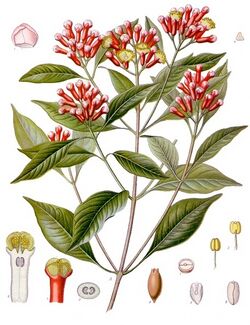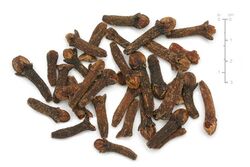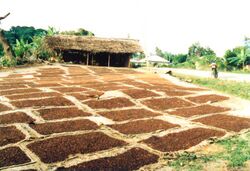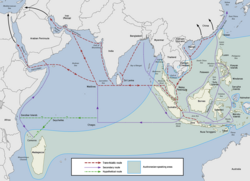Biology:Clove
| Clove | |
|---|---|

| |
| Scientific classification | |
| Kingdom: | Plantae |
| Clade: | Tracheophytes |
| Clade: | Angiosperms |
| Clade: | Eudicots |
| Clade: | Rosids |
| Order: | Myrtales |
| Family: | Myrtaceae |
| Genus: | Syzygium |
| Species: | S. aromaticum
|
| Binomial name | |
| Syzygium aromaticum (L.) Merr. & L.M.Perry
| |
| Synonyms[1] | |
| |
Cloves are the aromatic flower buds of a tree in the family Myrtaceae, Syzygium aromaticum (/sɪˈzɪdʒiːəm ˌærəˈmætɪkəm/).[2][3] They are native to the Maluku Islands, or Moluccas, in Indonesia, and are commonly used as a spice, flavoring, or fragrance in consumer products, such as toothpaste, soaps, or cosmetics.[4][5] Cloves are available throughout the year owing to different harvest seasons across various countries.[6]
Etymology
The word clove, first used in English in the 15th century, derives via Middle English clow of gilofer,[7] Anglo-French clowes de gilofre and Old French clou de girofle, from the Latin word clavus "nail".[8][9] The related English word gillyflower, originally meaning "clove", derives[10] via said Old French girofle and Latin caryophyllon, from the Greek Script error: The function "transl" does not exist. "clove", literally "nut leaf".[11][7]
Description
The clove tree is an evergreen that grows up to 8–12 metres (26–39 ft) tall, with large leaves and crimson flowers grouped in terminal clusters. The flower buds initially have a pale hue, gradually turn green, then transition to a bright red when ready for harvest. Cloves are harvested at 1.5–2 centimetres (5⁄8–3⁄4 in) long, and consist of a long calyx that terminates in four spreading sepals, and four unopened petals that form a small central ball.
Clove stalks are slender stems of the inflorescence axis that show opposite decussate branching. Externally, they are brownish, rough, and irregularly wrinkled longitudinally with short fracture and dry, woody texture. Mother cloves (anthophylli) are the ripe fruits of cloves that are ovoid, brown berries, unilocular and one-seeded. Blown cloves are expanded flowers from which both corollae and stamens have been detached. Exhausted cloves have most or all the oil removed by distillation. They yield no oil and are darker in color.[citation needed]
Uses


Cloves are used in the cuisine of Asian, African, Mediterranean, and the Near and Middle East countries, lending flavor to meats (such as baked ham), curries, and marinades, as well as fruit (such as apples, pears, and rhubarb). Cloves may be used to give aromatic and flavor qualities to hot beverages, often combined with other ingredients such as lemon and sugar. They are a common element in spice blends (as part of the Malay rempah empat beradik –"four sibling spices"– besides cinnamon, cardamom and star anise for example[12]), including pumpkin pie spice and speculaas spices.
In Mexican cuisine, cloves are best known as clavos de olor, and often accompany cumin and cinnamon.[13] They are also used in Peruvian cuisine, in a wide variety of dishes such as carapulcra and arroz con leche.
A major component of clove's taste is imparted by the chemical eugenol,[14] and the quantity of the spice required is typically small. It pairs well with cinnamon, allspice, vanilla, red wine, basil, onion, citrus peel, star anise, and peppercorns.
Non-culinary uses
It is often added to betel quids to enhance aroma while chewing.[15] The spice is used in a type of cigarette called kretek in Indonesia.[1] Clove cigarettes were smoked throughout Europe, Asia, and the United States. Clove cigarettes are currently classified in the United States as cigars,[16] the result of a ban on flavored cigarettes in September 2009.[17]
Clove essential oil may be used to inhibit mold growth on various types of foods.[18] In addition to these non-culinary uses of clove, it can be used to protect wood in a system for cultural heritage conservation, and showed the efficacy of clove essential oil to be higher than a boron-based wood preservative.[19] Cloves can be used to make a fragrant pomander when combined with an orange. When given as a gift in Victorian England, such a pomander indicated warmth of feeling.

Potential medicinal uses and adverse effects
The use of clove for any medicinal purpose has not been approved by the US Food and Drug Administration, and its use may cause adverse effects if taken orally by people with liver disease, blood clotting and immune system disorders, or food allergies.[5]
Cloves are used in traditional medicine as an essential oil, which is used as an anodyne (analgesic) mainly for dental emergencies and other disorders.[20] There is evidence that clove oil containing eugenol is effective for toothache pain and other types of pain,[5][21][22] and one review reported the efficacy of eugenol combined with zinc oxide as an analgesic for alveolar osteitis.[23] Clove essential oil may prevent the growth of Enterococcus faecalis bacteria which is often present in a root canal treatment failure.[24]
Studies to determine its effectiveness for fever reduction, as a mosquito repellent, and to prevent premature ejaculation have been inconclusive.[5][21] It remains unproven whether blood sugar levels are reduced by cloves or clove oil.[21] The essential oil may be used in aromatherapy.[5]
History

Until the colonial era, cloves only grew on a few islands in the Moluccas (historically called the Spice Islands), including Bacan, Makian, Moti, Ternate, and Tidore.[26] One clove tree named Afo that experts believe is the oldest in the world on Ternate may be 350–400 years old.[27]
Cloves were first traded by the Austronesian peoples in the Austronesian maritime trade network (which began around 1500 BC, later becoming the Maritime Silk Road and part of the Spice Trade). The first notable example of modern clove farming developed on the east coast of Madagascar , and is cultivated in three separate ways, a monoculture, agricultural parklands, and agroforestry systems.[28]
Archaeologist Giorgio Buccellati found cloves in Terqa, Syria, in a burned-down house which was dated to 1720 BC. This was the first evidence of cloves being used in the west before Roman times. The discovery was first reported in 1978.[29][30][31] They reached Rome by the first century AD.[32][33][34]
Another archeological find of a clove is represented by two examples found at a trading port in Sri Lanka, dated to around 900–1100 AD.[35] From Chinese records during the Song Dynasty (960 to 1279 AD), cloves were primarily exported from the Moluccas by ships originating from the Austronesian polities of Java, Srivijaya, Champa, and Butuan.[36]
Cloves were also present in records in China , Sri Lanka, Southern India, Persia, and Oman by around the third century to second century BC.[32][33][34] These mentions of "cloves" reported in China, South Asia, and the Middle East come from before the establishment of Southeast Asian maritime trade. But all of these are misidentifications that referred to other plants (like cassia buds, cinnamon, or nutmeg); or are imports from Maritime Southeast Asia mistakenly identified as being natively produced in these regions.[36]
During the colonial era, cloves were traded like oil, with an enforced limit on exportation.[27] As the Dutch East India Company consolidated its control of the spice trade in the 17th century, they sought to gain a monopoly in cloves as they had in nutmeg. However, "unlike nutmeg and mace, which were limited to the minute Bandas, clove trees grew all over the Moluccas, and the trade in cloves was beyond the limited policing powers of the corporation".[37] Tourists are told that seedlings from this very tree were stolen by a Frenchman named Pierre Poivre in 1770, transferred to the Isle de France (Mauritius), and then later to Zanzibar, which was once the world's largest producer of cloves.[27]
Current leaders in clove production are Indonesia, Madagascar , Tanzania, Sri Lanka, and Comoros.[38] Indonesia is the largest clove producer, but only export a small portion of the cloves they produce, which amounts to around 10–15% of the country's clove production. They oftentimes have to import cloves from Madagascar to meet their needs.[38]
Phytochemicals

Eugenol comprises 72–90% of the essential oil extracted from cloves, and is the compound most responsible for clove aroma.[14][39] Complete extraction occurs at 80 minutes in pressurized water at 125 °C (257 °F).[40] Ultrasound-assisted and microwave-assisted extraction methods provide more rapid extraction rates with lower energy costs.[41]
Other phytochemicals of clove oil include acetyl eugenol, beta-caryophyllene, vanillin, crategolic acid, tannins, such as bicornin,[14][42] gallotannic acid, methyl salicylate, the flavonoids eugenin, kaempferol, rhamnetin, and eugenitin, triterpenoids such as oleanolic acid, stigmasterol, and campesterol and several sesquiterpenes.[5] Although eugenol has not been classified for its potential toxicity,[39] it was shown to be toxic to test organisms in concentrations of 50, 75, and 100 mg per liter.[43]
Gallery
-
Kretek clove cigarettes, Indonesia
-
Cloves used in an orange as a pomander
-
Dried clove bud
See also
| Wikisource has the text of the 1911 Encyclopædia Britannica article Cloves. |
- Cinnamomum cassia
- Gallic acid
- Insect repellent
- Medicinal plant
References
- ↑ 1.0 1.1 {{citation | mode = cs1 | title = Syzygium aromaticum (L.) Merr. & L.M.Perry | work = Germplasm Resources Information Network (GRIN) | url = https://npgsweb.ars-grin.gov/gringlobal/taxonomydetail.aspx?50069 | publisher = [[Organization:Agricultural Research ServAgricultural Research Service (ARS), United States Department of Agriculture (USDA) | access-date = June 9, 2011 }}
- ↑ syzygium (3rd ed.), Oxford University Press, September 2005, http://oed.com/search?searchType=dictionary&q=syzygium (Subscription or UK public library membership required.)
- ↑ "Aqua aromatica". Merriam-Webster Dictionary. https://www.merriam-webster.com/dictionary/aqua+aromatica.
- ↑ "Syzygium aromaticum (L.) Merr. and L.M. Perry". Kew Science, Plants of the World Online. 2021. https://powo.science.kew.org/taxon/urn:lsid:ipni.org:names:601421-1.
- ↑ 5.0 5.1 5.2 5.3 5.4 5.5 "Clove". Drugs.com. 5 March 2018. https://www.drugs.com/mtm/clove.html.
- ↑ Yun, Wonjung (13 August 2018). "Tight Stocks of Quality Cloves Lead to a Price Surge". Tridge. https://www.tridge.com/stories/tridge-market-update-tight-stocks-of-quality-cloves-lead-to-a-price-surge.
- ↑ 7.0 7.1 Uchibayashi, M. (2001). "[Etymology of clove]". Yakushigaku Zasshi 36 (2): 167–170. ISSN 0285-2314. PMID 11971288.
- ↑ Harper, Douglas. "clove". Online Etymology Dictionary. https://www.etymonline.com/?term=clove.
- ↑ clavus. Charlton T. Lewis and Charles Short. A Latin Dictionary on Perseus Project.
- ↑ Harper, Douglas. "gillyflower". Online Etymology Dictionary. https://www.etymonline.com/?term=gillyflower.
- ↑ καρυόφυλλον. Liddell, Henry George; Scott, Robert; A Greek–English Lexicon at the Perseus Project
- ↑ Hariati Azizan (Aug 2, 2015). "A spicy blend of tradition". The Star: p. 9.
- ↑ Dorenburg, Andrew and Page, Karen. The New American Chef: Cooking with the Best Flavors and Techniques from Around the World, John Wiley and Sons Inc., 2003
- ↑ 14.0 14.1 14.2 Kamatou, G. P.; Vermaak, I.; Viljoen, A. M. (2012). "Eugenol--from the remote Maluku Islands to the international market place: a review of a remarkable and versatile molecule". Molecules 17 (6): 6953–81. doi:10.3390/molecules17066953. PMID 22728369.
- ↑ Rooney, Dawn F. (1993). Betel Chewing Traditions in South-East Asia. Kuala Lumpur: Oxford University Press. p. 26. ISBN 0-19-588620-8.
- ↑ "Flavored Tobacco". FDA. https://www.fda.gov/TobaccoProducts/GuidanceComplianceRegulatoryInformation/FlavoredTobacco/default.htm.
- ↑ "The Tobacco Control Act's Ban of Clove Cigarettes and the WTO: A Detailed Analysis" (in en). Congressional Research Service Reports. 17 September 2012. https://www.everycrsreport.com/reports/R42733.html.
- ↑ Ju, Jian; Xu, Xiaomiao; Xie, Yunfei; Guo, Yahui; Cheng, Yuliang; Qian, He; Yao, Weirong (2018). "Inhibitory effects of cinnamon and clove essential oils on mold growth on baked foods" (in en). Food Chemistry 240: 850–855. doi:10.1016/j.foodchem.2017.07.120. PMID 28946351. https://linkinghub.elsevier.com/retrieve/pii/S0308814617312736.
- ↑ Pop, Dana-Mihaela; Timar, Maria Cristina; Varodi, Anca Maria; Beldean, Emanuela Carmen (December 2021). "An evaluation of clove (Eugenia caryophyllata) essential oil as a potential alternative antifungal wood protection system for cultural heritage conservation" (in en). Maderas. Ciencia y tecnología 24. doi:10.4067/S0718-221X2022000100411. ISSN 0718-221X. http://www.scielo.cl/scielo.php?script=sci_arttext&pid=S0718-221X2022000100411&lng=es&nrm=iso&tlng=es.
- ↑ Balch, Phyllis and Balch, James. Prescription for Nutritional Healing, 3rd ed., Avery Publishing, 2000, p. 94
- ↑ 21.0 21.1 21.2 "Clove". MedlinePlus, U.S. National Library of Medicine and National Institutes of Health. 2014. https://www.nlm.nih.gov/medlineplus/druginfo/natural/251.html.
- ↑ "Eugenol - COLCORONA Clinical Trial". https://www.colcorona.net/de/haarausfall-nach-corona.
- ↑ Taberner-Vallverdú, M.; Nazir, M.; Sanchez-Garces, M. Á.; Gay-Escoda, C. (2015). "Efficacy of different methods used for dry socket management: A systematic review". Medicina Oral Patología Oral y Cirugia Bucal 20 (5): e633–e639. doi:10.4317/medoral.20589. PMID 26116842.
- ↑ "Effectiveness of Mixed Clove Flower Extract (Syzygium Aromaticum) And Sweet Wood (Cinnamon Burmanni) on the Growth of Enterococcus Faecalis". Indian Journal of Forensic Medicine & Toxicology 16 (1). 2022. doi:10.37506/ijfmt.v16i1.17639. https://medicopublication.com/index.php/ijfmt/article/view/17639.
- ↑ Manguin, Pierre-Yves (2016). "Austronesian Shipping in the Indian Ocean: From Outrigger Boats to Trading Ships". in Campbell, Gwyn. Early Exchange between Africa and the Wider Indian Ocean World. Palgrave Macmillan. pp. 51–76. ISBN 9783319338224. https://books.google.com/books?id=XsvDDQAAQBAJ&pg=PA50.
- ↑ Turner, Jack (2004). Spice: The History of a Temptation. Vintage Books. pp. xxvii–xxviii. ISBN 978-0-375-70705-6.
- ↑ 27.0 27.1 27.2 Worrall, Simon (23 June 2012). "The world's oldest clove tree". BBC News Magazine. https://www.bbc.co.uk/news/magazine-18551857.
- ↑ Arimalala, Natacha; Penot, Eric; Michels, Thierry; Rakotoarimanana, Vonjison; Michel, Isabelle; Ravaomanalina, Harisoa; Roger, Edmond; Jahiel, Michel et al. (August 2019). "Clove based cropping systems on the east coast of Madagascar: how history leaves its mark on the landscape" (in en). Agroforestry Systems 93 (4): 1577–1592. doi:10.1007/s10457-018-0268-9. ISSN 0167-4366. http://link.springer.com/10.1007/s10457-018-0268-9.
- ↑ Buccellati, G., M. Kelly-Buccellati, The Terqa Archaeological Project: First Preliminary Report., Les Annales Archeologiques Arabes Syriennes 27–28, 1977–1978, 71–96.
- ↑ Buccellati, G., M. Kelly-Buccellati, Terqa: The First Eight Seasons, Les Annales Archeologiques Arabes Syriennes 33(2), 1983, 47–67.
- ↑ Terqa – A Narrative. terqa.org.
- ↑ 32.0 32.1 Mahdi, Waruno (2003). "Linguistic and philological data towards a chronology of Austronesian activity in India and Sri Lanka". in Blench, Roger; Spriggs, Matthew. Archaeology and Language IV: Language Change and Cultural Transformation. Routledge. pp. 160–240. ISBN 9781134816248.
- ↑ 33.0 33.1 Ardika, I Wayan (2021). "Bali in the Global Contacts and the Rise of Complex Society". in Prasetyo, Bagyo; Nastiti, Titi Surti; Simanjuntak, Truman. Austronesian Diaspora: A New Perspective. UGM Press. p. 196. ISBN 9786023862023.
- ↑ 34.0 34.1 "Cloves". The University of Iowa. https://iwp.uiowa.edu/silkroutes/cloves.
- ↑ Kingwell-Banham, Eleanor. "World's oldest clove? Here's what our find in Sri Lanka says about the early spice trade" (in en). http://theconversation.com/worlds-oldest-clove-heres-what-our-find-in-sri-lanka-says-about-the-early-spice-trade-109686.
- ↑ 36.0 36.1 Ptak, Roderich (January 1993). "China and the Trade in Cloves, Circa 960–1435". Journal of the American Oriental Society 113 (1): 1–13. doi:10.2307/604192.
- ↑ Krondl, Michael. The Taste of Conquest: The Rise and Fall of the Three Great Cities of Spice. New York: Ballantine Books, 2007.
- ↑ 38.0 38.1 Pratama, Adnan Putra; Darwanto, Dwidjono Hadi; Masyhuri, Masyhuri (2020-02-01). "Indonesian Clove Competitiveness and Competitor Countries in International Market". Economics Development Analysis Journal 9 (1): 39–54. doi:10.15294/edaj.v9i1.38075. ISSN 2252-6560. https://journal.unnes.ac.id/sju/index.php/edaj/article/view/38075.
- ↑ 39.0 39.1 "Eugenol". PubChem, US National Library of Medicine. 2 November 2019. https://pubchem.ncbi.nlm.nih.gov/compound/3314.
- ↑ Rovio, S.; Hartonen, K.; Holm, Y.; Hiltunen, R.; Riekkola, M.‐L. (7 February 2000). "Extraction of clove using pressurized hot water". Flavour and Fragrance Journal 14 (6): 399–404. doi:10.1002/(SICI)1099-1026(199911/12)14:6<399::AID-FFJ851>3.0.CO;2-A.
- ↑ Khalil, A.A.; ur Rahman, U.; Khan, M.R.; Sahar, A.; Mehmood, T.; Khan, M. (2017). "Essential oil eugenol: sources, extraction techniques and nutraceutical perspectives". RSC Advances 7 (52): 32669–32681. doi:10.1039/C7RA04803C.
- ↑ Li-Ming Bao, Eerdunbayaer; Nozaki, Akiko; Takahashi, Eizo; Okamoto, Keinosuke; Ito, Hideyuki; Hatano, Tsutomu (2012). "Hydrolysable tannins isolated from Syzygium aromaticum: Structure of a new c-glucosidic ellagitannin and spectral features of tannins with a tergalloyl group". Heterocycles 85 (2): 365–381. doi:10.3987/COM-11-12392.
- ↑ Gueretz, Juliano Santos; Somensi, Cleder Alexandre; Martins, Maurício Laterça; Souza, Antonio Pereira de (2017-12-07). "Evaluation of eugenol toxicity in bioassays with test-organisms". Ciência Rural 47 (12). doi:10.1590/0103-8478cr20170194. ISSN 1678-4596.
External links
Wikidata ☰ Q26736 entry
 |




